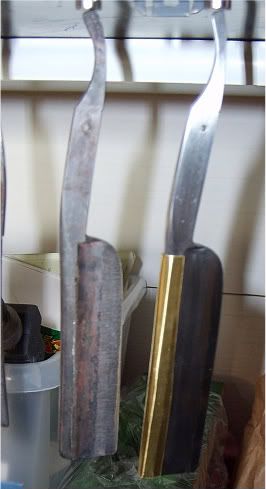Results 21 to 30 of 66
Hybrid View
-
08-22-2011, 03:51 PM #1

Some of the "all but new" large wedges I have seen were made to have the end of the spine a great deal wider than the pivot end. The edge geometry was set by the spine width.
I use these clips to do grinding and some serious honing to bring a abused edge back:

The sides must be absolutely equal for their full length. And they must be fully against the spine and not able to move. The sides must be as short as possible from back of the spine for a wedgy razor because the edge side of the side sets the hone angle. that edge does not go into the hollow of the grind as on a hollow ground razor as shown in the photo. There the spine cover is contacted along the original line of the spine.
Now, If I were to guess, that clip/hone aid could be shaped to the profile wanted at the edge by shaping BOTH sides exactly.Be yourself; everyone else is already taken.
- Oscar Wilde
-
The Following User Says Thank You to Geezer For This Useful Post:
Disburden (12-16-2011)
-
08-22-2011, 04:08 PM #2'tis but a scratch!



- Join Date
- Oct 2010
- Location
- Durango, Colorado
- Posts
- 2,080
- Blog Entries
- 2
Thanked: 443
Hi Geezer,
I always like your posts. Germane and informative.
Where do you get these clips?"These aren't the droids you're looking for." "These aren't the droids we're looking for." "He can go about his business." "You can go about your business."
-
08-23-2011, 02:11 PM #3

Hi, roughtype,
Thank you!
I bought a box of hard brass shim stock long ago in a past life as a machinist. They make it in stainless steel too. A local small machine shop would have the shim stock to cadge a piece from. An old steel can could do the job well and is thin enough to work for most blades.. Aluminum may load the hone quickly
An advantage to shim stock is that it is available in thicknesses from ~0.ooo5 to 0.o5o
Since most every blade is different, they are a one off for each.
I just use a pair of sheet metal pliers called seamers at HF.to form the clip and then trim it with a scissors.

Vise Grip and other makes of seamers and welding pliers are available. Make sure that the jaws meet exactly. I usually end up filing them to a match at the edge. It will take a bit of practice and then, you will be able to gauge the correct spacing and seal the clips onto the spine tightly. I squeeze them onto the blade below the spine if it is a hollow grind. Just assure that the spine hits the hone; not the edge of the clip.
If you notice the hone wear on the clip in the photo a couple posts back, you will see where the hone meets the covered spine and the clip is formed around the spine and into the hollow.
enjoy!Be yourself; everyone else is already taken.
- Oscar Wilde
-
The Following User Says Thank You to Geezer For This Useful Post:
roughkype (08-23-2011)


 19Likes
19Likes LinkBack URL
LinkBack URL About LinkBacks
About LinkBacks









 Reply With Quote
Reply With Quote